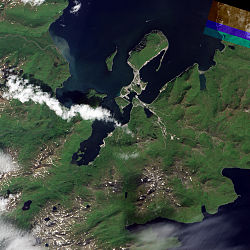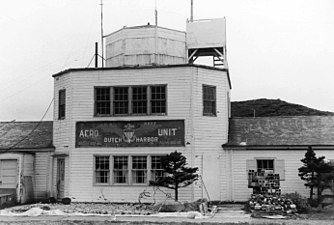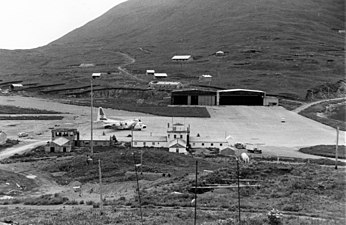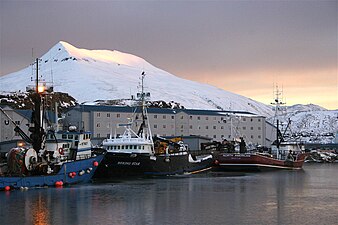Dutch Harbor
Dutch Harbor | |
|---|---|
Harbor | |
 Natural-colour image of Dutch Harbor | |
 Dutch Harbor Show map of Unalaska  Dutch Harbor Show map of Alaska | |
| Coordinates: 53°54′10.5″N 166°31′06.2″W / 53.902917°N 166.518389°W / 53.902917; -166.518389Coordinates: 53°54′10.5″N 166°31′06.2″W / 53.902917°N 166.518389°W / 53.902917; -166.518389 | |
| Country | United States |
| City | Unalaska, Alaska |
| Time zone | UTC-9 (Alaska (AKST)) |
| • Summer (DST) | UTC-8 (AKDT) |
Dutch Harbor is a harbor on Amaknak Island in Unalaska, Alaska. It was the location of the Battle of Dutch Harbor in June 1942, and was one of the few sites, besides the attack on Pearl Harbor in Hawaii, in American territory to be bombed by the Japanese during World War II.[1]
Dutch Harbor is now the home of an important fishing industry.[2]
Contents
1 Russian to American
2 World War II
3 Post-World War II
4 Current events
5 Demographics
6 Fishing
7 References
Russian to American
Druzhinin, the commander of the Russian ship Zakharii I Elisaveta, is credited for discovering the deep-water harbor now known as Dutch Harbor.
Dutch Harbor is located within the Aleutian Islands of Alaska, more precisely on Amaknak Island in the Fox Islands. A mile long spit extending from the northeast end of Amaknak Island makes Dutch Harbor a natural port, protecting ships from the waves and currents of the Bering Sea, although winds off the Bering Sea have tossed shipments from decks of ships. Dutch Harbor is close to some of the richest fishing in the world, and it is ice-free.
The native people are known as the Aleut. When the Russians arrived, they exploited the Aleut by taxing them in fur pelts.
The Aleut accepted the Russian Orthodox Church because it offered them support and educated their children.[citation needed]
The Russian-American Company operated from 1799 through the mid-1800s. It used Dutch Harbor in the transport of goods, mainly seal and sea otter fur.
In 1867 Russia sold Alaska to the United States.
Fur was the main export in Alaska after the United States took control. Hutchinson, Kohl, & Company of San Francisco took over the assets of the Russian America Company in 1867, but it sold out in 1868 to the Alaska Commercial Company.
A decline in the sea otter population slowed trade in 1895.
The year 1897 brought a crowd of potential prospectors looking to get rich from the Alaska gold rush.[3]
World War II
World War II brought the U.S. Army and Navy, and their supplies, to Dutch Harbor at the Dutch Harbor Naval Operating Base and Fort Mears, U.S. Army. The first army troops arrived in June 1941 and the navy air base was finished in September 1941. During the war, Dutch Harbor was also used to house refugees evacuated from other Aleutian Islands.
U.S. Army troops and civilian workers alike spent time at "Blackies", the only bar in the area. This establishment had cheap beer and 50-cent shots of whiskey, but no stools or chairs as they "splintered too easily in event of a fight". Other entertainment included a brothel named "Pleasure Island", but this was closed in 1941 and later replaced by part of the U.S. Navy submarine base. The 500-man mess hall doubled as a theater. The tickets for military were 15 cents and 35 cents for civilian workers.[3]
In early 1942, intelligence officers of the U.S. Navy predicted that there would be a Japanese attack in the North Pacific area, and naval codebreakers warned Dutch Harbor of the impending attack. On June 3, 1942, at 5:45 a.m., 20 Japanese planes from two aircraft carriers of the Imperial Japanese navy bombed Dutch Harbor in the "Battle of Dutch Harbor," targeting the radio station and the petroleum storage tanks.
By mid-1942, a small submarine base was in place, with a squadron of old U.S. Navy S-class submarines.
By May 1943, a peak of 10,151 sailors and 9,976 soldiers were stationed at the base.[citation needed]
Post-World War II
In 1947, the last units of the U.S. Navy left Dutch Harbor and the base was decommissioned.
In 1952, the U.S. Army Corps of Engineers stored 232 surplus buildings on 448 acres of land of the Fort Mears Military Reservation.
During the mid-1980s, the US government finally funded a cleanup of the derelict fort, and the area was turned over for commercial use. The U. S. Navy also scrapped its air base on it.
Current events
The harbor is prominently featured in the Discovery Channel reality television series Deadliest Catch, which has been airing there since 2005.
Demographics
| Historical population | |||
|---|---|---|---|
| Census | Pop. | %± | |
| 1930 | 17 | — | |
| 1940 | 52 | 205.9% | |
| U.S. Decennial Census[4] | |||
Dutch Harbor first appeared on the 1930 U.S. Census as an unincorporated village. It returned lastly in 1940, and did not appear again separately afterwards. It was later annexed into Unalaska.
Fishing
Dutch Harbor is ranked as a top fishing port with more than a billion dollars transferred each year. Huge harvests of pollock and cod in the Bering Sea are part of this total. The Bering Sea has a continental shelf that is one of the world’s largest, and supports a rich ecosystem.[5]

Dutch Harbor Attack - June 1942

Buildings burning after the first Japanese attack, 3 June 1942.

Naval Operating Base in 1972

The building at Dutch Harbor airport used as communication room and terminal with the old U.S. Navy Aero Unit insignia in August 1972

View of Dutch Harbor ramp area with a USCG C-130 Hercules in stand by for an emergency flight.

Crab boats docked at Dutch Harbor in January 2009.
References
| Wikimedia Commons has media related to Dutch Harbor. |
| Wikivoyage has a travel guide for Dutch Harbor-Unalaska. |
^ Unalaska - History of Unalaska
^ Unalaska - About Unalaska
^ ab Campbell, L. J., & Alaska Geographic Society. (1991). Unalaska/Dutch Harbor. Anchorage, Alaska: Alaska Geographic Society.
^ "U.S. Decennial Census". Census.gov. Retrieved June 6, 2013..mw-parser-output cite.citation{font-style:inherit}.mw-parser-output .citation q{quotes:"""""""'""'"}.mw-parser-output .citation .cs1-lock-free a{background:url("//upload.wikimedia.org/wikipedia/commons/thumb/6/65/Lock-green.svg/9px-Lock-green.svg.png")no-repeat;background-position:right .1em center}.mw-parser-output .citation .cs1-lock-limited a,.mw-parser-output .citation .cs1-lock-registration a{background:url("//upload.wikimedia.org/wikipedia/commons/thumb/d/d6/Lock-gray-alt-2.svg/9px-Lock-gray-alt-2.svg.png")no-repeat;background-position:right .1em center}.mw-parser-output .citation .cs1-lock-subscription a{background:url("//upload.wikimedia.org/wikipedia/commons/thumb/a/aa/Lock-red-alt-2.svg/9px-Lock-red-alt-2.svg.png")no-repeat;background-position:right .1em center}.mw-parser-output .cs1-subscription,.mw-parser-output .cs1-registration{color:#555}.mw-parser-output .cs1-subscription span,.mw-parser-output .cs1-registration span{border-bottom:1px dotted;cursor:help}.mw-parser-output .cs1-ws-icon a{background:url("//upload.wikimedia.org/wikipedia/commons/thumb/4/4c/Wikisource-logo.svg/12px-Wikisource-logo.svg.png")no-repeat;background-position:right .1em center}.mw-parser-output code.cs1-code{color:inherit;background:inherit;border:inherit;padding:inherit}.mw-parser-output .cs1-hidden-error{display:none;font-size:100%}.mw-parser-output .cs1-visible-error{font-size:100%}.mw-parser-output .cs1-maint{display:none;color:#33aa33;margin-left:0.3em}.mw-parser-output .cs1-subscription,.mw-parser-output .cs1-registration,.mw-parser-output .cs1-format{font-size:95%}.mw-parser-output .cs1-kern-left,.mw-parser-output .cs1-kern-wl-left{padding-left:0.2em}.mw-parser-output .cs1-kern-right,.mw-parser-output .cs1-kern-wl-right{padding-right:0.2em}
^ Kloosterboer dutch harbor; kloosterboer forecasts busy 2010 for expanded dutch harbor port facility. (2009). Leisure & Travel Week, , 31. Retrieved from http://search.proquest.com/docview/201731337





